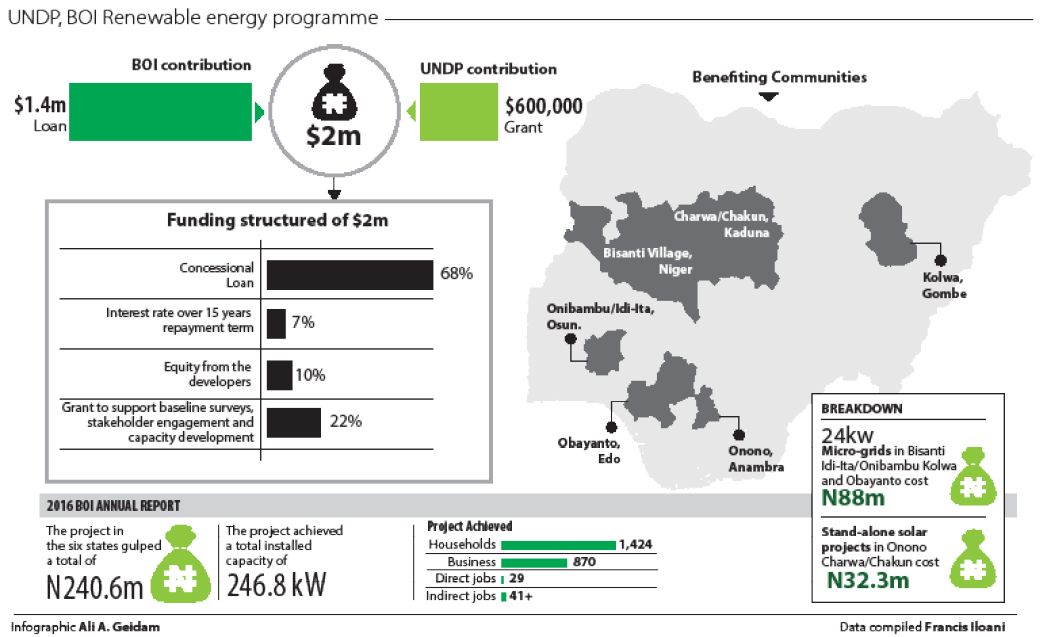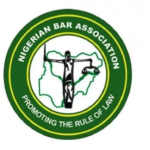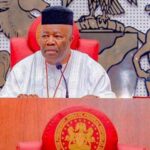Although the Federal Government has invested N240.6 million on renewable energy projects across six rural communities to provide sustainable power, investigation by Daily Trust on Sunday shows that those communities still suffer outages over the poor condition of the facilities.
The projects were executed by the Bank of Industry (BoI) and the United Nations Development Programme (UNDP) to provide solar-powered electricity to several rural communities.
On September 28, 2016, the Bank of Industry and the UNDP signed a $2m (about N723m) pact to power the off-grid communities with solar electricity.
The funding arrangement was that the BoI contributed $1.4m loan to the project, while the UNDP provided $600,000 balance as grant.
Speaking during the signing of the cost sharing pact between the two development institutions, the then BoI’s acting managing director, Waheed Olagunju said, “The blend of BoI’s contribution in the sum of $1.4 million as debt financing for the projects, with UNDP’s grant contribution of $600,000 will provide the much needed stimulus to scale up the projects in view of the attendant reduction in the cost of deployment and enhancement of its overall viability.”
According to the 2016 annual report of the BoI, the initial six communities are Bisanti village in Niger State, Kolwa in Gombe, Onono in Anambra, Obayanto in Edo, Charwa/Chakun in Kaduna, and Onibambu/Idi-Ita in Osun State.
The projects in the six states gulped N240.6m from the $2m renewable energy fund. A breakdown shows the 24 kilowatt (KW) micro-grids in Bisanti, Idi-Ita/Onibambu, Kolwa and Obayanto gulped N44m each. The stand-alone solar projects in Onono, and Charwa/Chakun took N32.3m each.
Two renewable energy project contractors handled the six projects. While GVE Projects Limited is the service provider for projects in Niger, Edo and Anambra communities, Arnergy Solar Limited executed projects at communities in Osun, Kaduna and Gombe.
The six mini grids were commissioned between October 6, 2015, and May 21, 2016. “Testimonies from the six communities where we have successfully commissioned off-grid solar solutions are quite positive.
“Living standard has improved, quality of lives has been enhanced and commercial activities have equally picked up, especially micro, small and medium enterprises,” Olagunju had said later in 2016.

R: A solar-powered house in a flooded area of Onono community of Anambra State
However, when our reporter visited the communities recently in a survey of the projects’ status, the beneficiaries were full of lamentations.
A resident of Charwa/Chakun, who benefitted from the standalone solar power, Jamilu Sani, said despite paying N1500 monthly, the electricity lasts for about six and a half hours daily, leaving him in darkness at nights.
Sani revealed that whenever it broke down, it would take about three months to be fixed, and the solar panels usually go bad during the rainy seasons.
“This rainy season, for instance, I didn’t really enjoy the solar because it always had issues,” he said.
The village head of Charwa/Chakun in Makarfi Local Government Area of Kaduna State, Abdulhamid Abubakar, told Daily Trust on Sunday that he was not comfortable with the long duration of time it usually took to fix the solar panels when they broke down.
Abubakar said he paid N1, 500 monthly and got six hours of electricity daily, but took a minimum of a month for the solar to be fixed whenever it developed faults.
“We frequently pay our dues for the light and we wonder why it takes long for the relevant authorities to repair the solar if it goes bad,’’ he lamented.
Another beneficiary, Balarabe Umar, said he got five hours of electricity during the day, but when the solar got bad, it took a minimum of two months before it is repaired.
“I am a shop owner and I use this light to charge phones and make some profits, that is why I pay my bills often, but when it goes bad my business will be suspended till it is repaired, which makes me lose a lot of money in the process,’’ Umar said.

While Amina Hassan, a resident of Charwa/Chakun appealed to the state and Federal Government to be connected to the national electricity grid, Rukkaiyat Musa said the solar power brought temporary respite to the residents of the community.
Findings by Daily Trust on Sunday in Onono community of Anambra State were similar to what was discovered in Charwa/Chakun community of Kaduna State.
The Bank of Industry and other stakeholders commissioned the standalone solar project in the remote off-grid fishing community on March 4, 2016.
A beneficiary of the project in Onono community, The Rev John Uzodigwe of Christ Holy Church International, located at Udeme Onono, Umuikwu Anam, told our reporter that the solar power served his household only during the day because of its low battery strength.
He said the solar electricity cost him N2000 monthly, but in the case of any malfunction in his household, it took a period of two to three weeks before it could be fixed.
John said when it was initially installed, it functioned well until it gradually started developing battery problem in almost all the households that benefitted.
He said he subscribed promptly for the epileptic electricity but that most users in the community stopped prompt payments since the battery issue came up. He appealed to the relevant authority to connect the community to the national grid as the solar project would not permanently solve the electricity needs of his people.
Theresa Obadigbo from Umuogbaru of Onono community also lamented the weakness of the battery, explaining that the first one given to her weakened and it was replaced, and the new one is also weak.
Obadigbo said she would want to purchase the battery if a good and durable one could be found in the market.
She said the weakness of the batteries had limited the solar system operations to some extent as it only served her and some other users for few hours during the day and without light at night.
Daily Trust on Sunday also received complaints about the weakness of the micro-grids at Bisanti, Idi-Ita/Onibambu, Kolwa and Obayanto, and their inability to serve residents at night.
For instance, a beneficiary of the solar electricity at Idi-Ita/Onibambu, Ife North Local Government Area of Osun State, Odekunle Jacob, said the solar micro-grid in his community was functioning well before November, 2018 when it packed up.
Odekunle said the micro-grid was reinstalled, after which it only served he community from 7am to 6am because of the weakness of the batteries.
“For now, it is only serving in the day, but in the night, which is very essential for us, it is absent. We want you to come and reactivate it for us so that it can perform at night,” Odekunle said.
He explained that they made payment in a prepaid format; they gather money and send to Lagos to get the voucher, and this could take weeks before they get recharged.
The situation of Idi-Ita/Onibambu is similar to the findings in Bisanti, a remote community in Niger State, where beneficiaries also complained of the inability of the solar micro-grid to serve them at night.
A beneficiary of 24KW micro-grid solar electrification system in Bisanti, Musa Ya’u, said the power of the solar system had diminished, and this has affected electricity supply at night.
At Kolwa in Kaltungo Local Government Area of Gombe State, it was discovered that most of the households in the community benefitted from the 24KW micro-grid solar power.
A beneficiary from Kolwa, Iliyasu Isa, said sometimes the battery would go weak when the water level was low or heavy wind may blow off the solar panels and this would affect the power supply. He said the engineers usually had ways of fixing the problem to restore power supply.

Another beneficiary, Sallon Kifi, said though the overall grid functioned well in the community, the supply to his household had broken down. He said apart from the many processes involved in recharging the meters and the long time it takes, the solar served the community well.
He said some beneficiaries who slept in darkness may be witnessing faults at their households or they were not able to renew their subscriptions.
Daily Trust on Sunday spoke to the agent saddled with the responsibility of the day-to-day running of the standalone solar power in Onono (Anambra) on behalf of the service provider, GVE Projects Limited, to ascertain the state of the project in the community. The agent, Mr Joseph Uyebo, disclosed that a total of 200 houses and three shops were connected to the grid.
It was also gathered that not every household was successfully connected or got the solar grid installed in their houses at the first installation, but as time went on, it reached majority of the households.
Mr Uyebo attributed the challenges of the solar standalone power in the community to the flooding witnessed in the community. He said the flood damaged, and to a large extent, weakened the batteries, a situation that made it difficult to have steady supply of electricity in the community. He said there was nothing wrong with the solar system, and that if the batteries were fully recharged or replaced with new ones, the solar grid would be sound in its operations again.
He said what stood now as a major hindrance to the solar system’s full operation was the weakness of most of the batteries in most households, which had reduced the operational ability of the solar system to basically serve the entire community only during the day but goes off automatically during the night hours.
Similarly, the agent in charge of the micro-grid control room at Idi-Ita/Onibambu community of Osun State on behalf of Arnergy Solar Limited attributed the inability of the grid to supply electricity at night to weak batteries.
While taking our reporter round the control room and pointing out the differences in the batteries, the agent, who identified himself as Mr. Adebayo, said every other thing was functioning well except the batteries.
Adebayo said the project was not meant to scam the community as once the batteries are replaced, residents of the community would enjoy electricity at night.
The UNDP’s Final Terminal Evaluation Report of the Solar Energy Programme jointly carried out with the BoI rated the “overall likelihood of the sustainability” of the solar projects in the communities as “moderately likely.”
The 2018 report included the name of the project evaluator as Dr. Jason Yapp, who is a consultant to UNDP and also the principal partner, Always Green Power and Systems Limited, United Kingdom.
The report faulted the monitoring and evaluation plan and implementation of the project and rated it as “moderately satisfactory.”
“The indicators and targets provided in the project document were not specific, measureable, achievable, realistic or time-bound). No indicators or targets were included at the medium term outcome (five years after project has ended) and impact levels (10 years after project has ended), thus making it difficult to assess the medium and long-term impact of the project,” the report stated.
The report revealed that despite the fact that the BoI advised the service providers to use UNDP’s monitoring and evaluation templates, this was not adhered to.
“The project developers were not given the document and did not fully understand the design, monitoring and evaluation plan and the theory of change principles,” the report stated.
The report also noted that current electricity tariff rates in Nigeria are subsidised at N25/kWh for residential, N40/kWh for commercial and N5/kWh for community, and this is cheaper than the N150 to N180/kWh that are imposed on current end users of the solar power project.
The report recommended the need to close the wide gap between the subsidised rates Nigerians pay for electricity with the rates paid for the solar power, with a possible reduction to a competitive N70/kWh from the current N150 to N180/kWh.
The report, however, revealed that the effectiveness of the project had been deemed as “satisfactory” in achieving total installed capacity of 246.8 kW, connecting 1,424 households, 870 businesses, creating 29 direct jobs (as technicians, security guards) and creating over 41 indirect jobs from micro-businesses.
Dr. Yapp advised the BoI and UNDP to carry out a post-evaluation study in 2020 to quantify and detail on the impacts of the project.
Responding to Daily Trust on Sunday’s inquiry on the state of the project, the head of Corporate Communications of the Bank of Industry, Hadiza Olaosebikan, said the solar projects in the benefiting communities had met the expectations of the bank, “in the sense that they have served as reference projects for so many investors in the sector, both local and foreign.”
Olaosebikan said the likes of Power Africa, DFID, USAID, GIZ and a couple of local investors decided to invest in similar projects because of the positive impacts these projects had and continue to have on the beneficiaries.
The UNDP report revealed that the $2 million funding were structured as 68 per cent concessional loan with 7 per cent interest rate over 15 years repayment term, 10 per cent equity from the developers and 22 per cent grant to support baseline surveys, stakeholder engagement and capacity development.
She described the extent of the loan repayment as “good,” adding that two developers have been able to raise additional funding from both local and international investors, which has also increased their capacities for repayment of the loan.
“Simply put, the massive investment we are seeing in the space today was driven by the plunge the bank took in the sector years back, which has also encouraged resources, events and agents to play their rightful roles in the off-grid (both the rural and the energising economy programme),” she said.
This investigation was funded by Daily Trust Foundation and supported by MacArthur Foundation.




